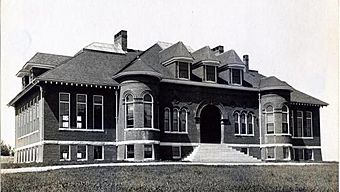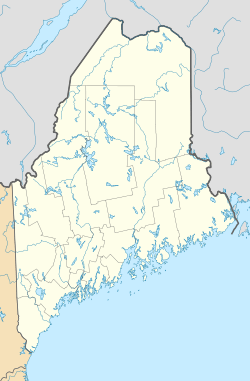L. C. Bates Museum facts for kids
Quick facts for kids |
|
|
Quincy Building
|
|

The Quincy Building, not long after its construction
|
|
| Nearest city | Hinckley, Maine |
|---|---|
| Area | 1 acre (0.40 ha) |
| Built | 1903 |
| Architect | William R. Miller |
| Architectural style | Romanesque |
| NRHP reference No. | 78000330 |
| Added to NRHP | October 4, 1978 |
The L.C. Bates Museum is a fascinating museum located in Hinckley, Maine, United States. It's part of the Good Will-Hinckley campus, which is a special school. This museum focuses on natural history and local culture. It was started by George Walter Hinckley (1853–1950). He created it as part of the Good Will Home, which was a groundbreaking place that helped children who needed support and education.
Contents
What is the L.C. Bates Museum?
The museum is inside a building called The Quincy Building. This building was constructed in 1903. It has a unique design called Romanesque Revival style and is made of brick. A famous architect from Lewiston, Maine, named William R. Miller (1866–1929), designed it.
History of the Quincy Building
When it was first built, The Quincy Building was used for industrial training. But by the early 1920s, it was changed to house the museum. The building is special because of its cool terracotta decorations and arched windows. It's even listed on the National Register of Historic Places, which means it's a very important historical site.
What You Can See Inside
People often call the L.C. Bates Museum a "Museum of a Museum." This is because it has some of the best-preserved museum rooms from the early 1900s in Maine. When you visit, you can explore many different exhibits.
- Habitat Dioramas: There are 32 dioramas that show different natural habitats in Maine. These are like 3D scenes that make you feel like you're looking at real animals in their natural homes.
- Animal Galleries: You can see galleries filled with birds, mammals, marine life, insects, and reptiles.
- Mineral Displays: There's also a collection of interesting minerals.
- Hands-on Exhibits: The museum also has exhibits where you can touch and interact with things, making learning even more fun.
The detailed backgrounds for the dioramas were painted in the 1920s. They were created by a well-known American Impressionist painter named Charles Daniel Hubbard (1876–1951).
Exploring Sun Set Park
Outside the museum, you'll find Sun Set Park. This is an arboretum, which is like a park filled with different kinds of trees and plants. Parts of this park were designed by the famous Olmsted Brothers landscape architecture company. Sun Set Park has natural areas and walking trails. These trails are a great way to enjoy nature and learn more about Maine's natural history, just like the museum.
More Museums to Explore
- List of natural history museums
- List of museums in Maine
- National Register of Historic Places listings in Somerset County, Maine



